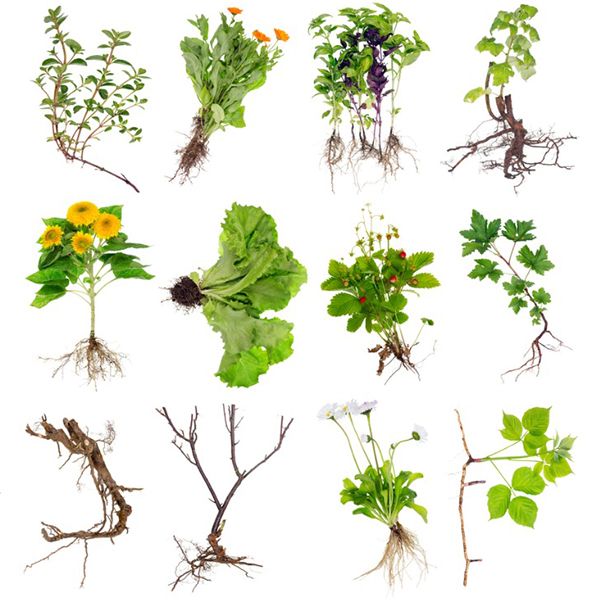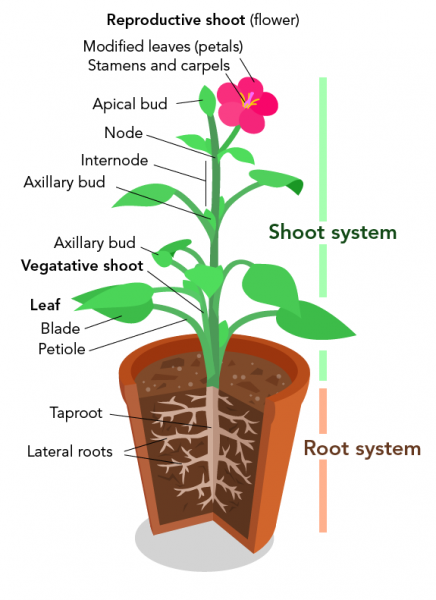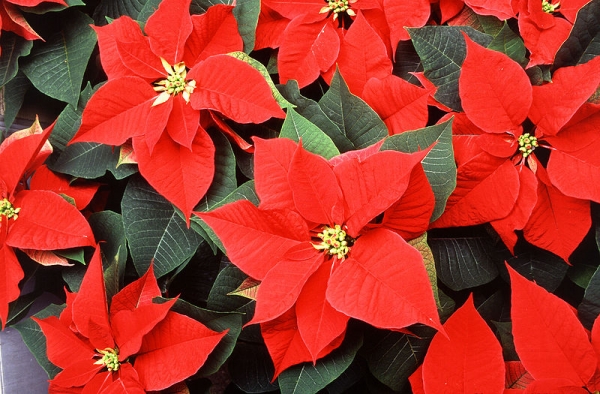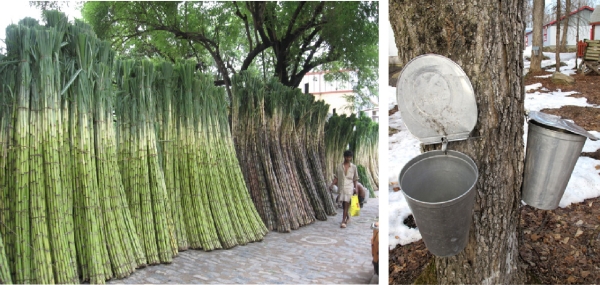Parts of a Plant

Variety of plants (Dvavlt, iStockphotos)

Variety of plants (Dvavlt, iStockphotos)
How does this align with my curriculum?
What are the main parts of plants and what functions do these parts serve for plants?
Parts of a Plant
Just as people have tissues and organs, plants also have specialized tissues and structures. In plants, these tissues and structures fall into two main categories. These are the shoot system and the root system.
The shoot system is made up of leaves, stems, and reproductive structures. Reproductive structures include flowers, fruit, and seeds. The root system is made up of - you guessed it - roots! Let’s learn more about these structures.

Image - Text Version
Shown is a colour diagram of a potted plant, with its parts and systems labelled.
The plant is green with pointed oval leaves and one pink flower. The parts above the soil are marked with a pale green stripe labelled "Shoot system." The parts below the soil are marked with a beige stripe labelled "Root system."
Starting from the bottom, the pot is cut away to show the roots inside. The thick central root is labelled "Taproot". The thinner roots that branch off from this are labelled "Lateral roots."
Above the soil, the bottom leaf is labelled with the heading "Leaf", in bold letters. Below this, the flat, green part of the leaf is labelled "Blade", in regular font. The stalk that leads to the leaf is labelled "Petiole".
Above this, a new, small branch off the main stem is labelled "Vegetative shoot" in bold letters. a rounded conical shape at the end of it is labelled Axillary bud, in regular font. Another, similar Axillary is labelled above. It grows from the main stem.
The part of the stem between two petioles is labelled "Internode." The area where several branches grow off the main stem is labelled "Node."
At the top of the stem, in the centre, is a teardrop-shaped structure labelled "Apical bud".
Below and to the right, the flower is labelled with the heading "Reproductive shoot (flower)". Its scalloped pink petals are labelled "Modified leaves (petals)". The tiny yellow structures in the centre of the flower are labelled "Stamens and carpels".
Leaves
Leaves are the mostly flat green parts of plants.
The scientific word for the flat part of a leaf is lamina. It is also known as the leaf blade. The scientific word for the part of the leaf which attaches to the stem is petiole. It is also known as a leaf stalk). Most, but not all, leaves have these parts.
The role of a leaf is to:
- provide a place for photosynthesis to occur; and
- be involved in transpiration of water.
Leaves are usually large and flat. This is so that they can expose as many of their chloroplasts to sunlight as possible. Chloroplasts are where photosynthesis happens.
Other leaves have specialized functions giving them unusual shapes and colours. Some you might not even recognize as leaves! The thin needles on pine trees and other conifers are actually leaves. Their small surface area combined with a waxy covering helps these leaves to minimize water loss.
Have you ever seen a Poinsettia plant like the one below?

Image - Text Version
Shown is a colour photograph of plants with red and green leaves, from above.
The image is filled with plants with teardrop-shaped, pointed leaves. The lower leaves are dark green. But at the top of each stem, there are 8-10 bright red leaves in the same shape. They overlap in a starburst pattern that looks like a flower. In the centre of each set of red leaves are tiny, round, yellow structures. A few of them have sprouted small, pointed yellow leaves.
What appear to be red flowers are actually specialized structures called bracts. The flowers are the little yellow things in between the red bracts. Bracts are specialized leaves. They help to attract such as bees and birds to the flowers. For many plants, pollinators are needed to transfer from one flower to another so the plants can reproduce.
Stems
The stem is the structure which forms the core of the shoot system. The stem is divided into two parts. These are the nodes and internodes.
Nodes are where buds grow into leaves, stems, or flowers. Internodes are the parts of the stem in between the nodes. In most plants, stems are found above the ground. For some plants, such as potatoes, stems are also found below the ground. The part of the potato plant we eat, called a tuber, is a specialized underground stem which stores nutrients for the plant.
The role of the stem is to:
- provide support for the plant;
- provide a place for leaves, flowers and fruit to grow;
- keep leaves facing towards sunlight;
- transport water and nutrients up from the roots and transport the products of photosynthesis down from the leaves; and
- store nutrients.
Humans have many uses for plant stems. We get sugar from sugar cane stems. We also make maple syrup from the found in maple tree stems. We don’t normally call this part of the tree a stem, we call it a trunk.

Image - Text Version
Shown are two colour photographs. One of two buckets attached to the trunk of a tree and one of stacks of very tall plant stems.
In the left image, bundles of long thin, stems with tufted green tops are stacked against each other so they stand upright. The stacks on the left are pale green, but the stacks on the right are greyish brown. They stretch along a path across the width of the photograph. The stems are about double the height of a person walking along the path.
In the right image, the tree has rough, thick, brown and grey bark. It stretches the length of the image, and no branches or leaves are visible.
The buckets are silver metal with flat lids. The first is attached to the front of the tree and the second to the right side. The lid on the first bucket is propped open against the bark above. Underneath, a small metal tube leads from the tree, over the rim of the bucket. The second bucket is the same, but its lid is closed.
In the background, the ground is covered in half-melted snow and brown leaves.
You may know that paper and wood also come from tree stems. But did you know that cinnamon and cork also come from tree stems? They are both made from the outer layer of the tree stem called the bark.
Roots
The root system is the system of structures that are usually found underground.
The role of roots is to:
- anchor the plant to the ground;
- take up water and minerals needed for growth and development;
- store food and nutrients; and
- provide a means of reproduction called vegetative (asexual) reproduction.
Although roots are generally below ground, they still need oxygen. Generally, this small quantity of oxygen is found naturally between the grains of soil. However, if the soil becomes filled with water, the oxygen is forced out. If the roots cannot get enough oxygen, the plants will start to produce roots above ground.
Roots can be thin and hair-like. We call these fibrous roots. Roots can also be short and thick, We call these taproots. Roots that grow above ground we call buttress roots.You can see examples of these three types of roots below.

Image - Text Version
Shown are three colour photographs of the roots of three different plants.
Starting on the left, the first image shows a cylinder of dark brown soil laced with white roots, like thread or tangled hair. It looks as if the soil was lifted out of a plant pot in one piece, and the roots are growing all around and through it, holding it together.
The second image shows the hands of a person holding about 12 large carrots. They are grasping them by their green tops, with the thick, pointed orange parts fanned out in front of them. The carrots have clumps of dark soil clinging to them. The ground below is dense with more green carrot tops.
The third image shows a large grey tree with what looks like 10-12 trunks. Its roots are the same colour and thickness as the trunks. They grow out across the ground, on top of the soil, in every direction away from the trunks.
Learn More
An interactive for kids from the University of Illinois that has activities about the parts of a plant and how they grow.
Plant Cells: Crash Course Biology #6 (2012)
Crash Course video (10:27 min.) about plants and plant cells, and discussing the evolution of plants.
References
The Canadian Encyclopedia. (2006, February 7). Plant.
Bailry, R. (2019). Parts of a flowering plant. ThoughtCo.